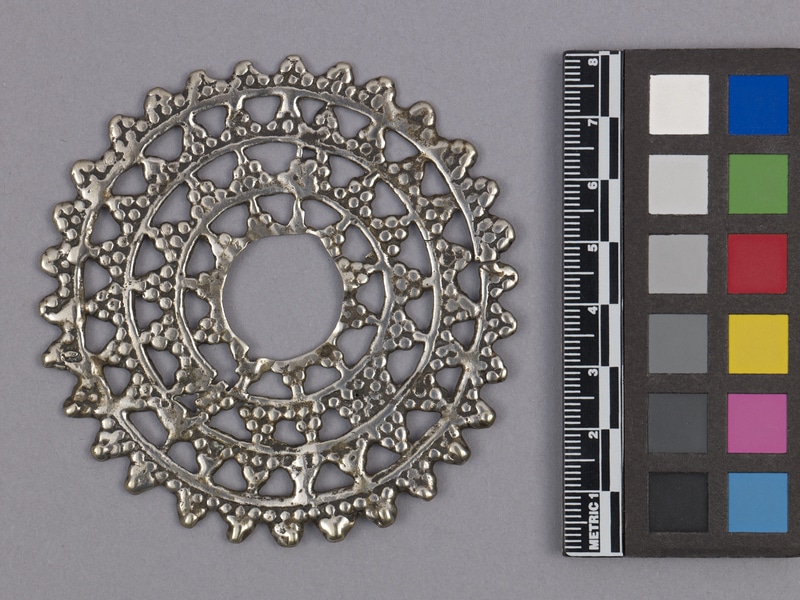Ornament Item Number: 2878/10 from the MOA: University of British Columbia

Description
Hammered, silver, circular ornament made up of four concentric circles, each of which supports a repeating pattern of a triangular motif. Each triangle is made up of six dots or circles, widest at the base, with the single topmost dot attaching to the next concentric circle. The number of triangles in each circle increases with the increased size of each concentric circle.
History Of Use
Kalash'a girls and women sew these ornaments or "chama" onto their dresses, as well as onto the back of their cowrie-studded headdress (known as "shushut", worn closest to the skull) and "kopas" (worn overtop of the shushut. Chitrali women also sometimes wear these on their "shalwar-kamees" or shirt/pant outfits.
Specific Techniques
These ornaments are made of 'German silver" (silver and tin alloy), and are made by casting, applying small pieces of silver that are heated and hammered (granulation technique) and polished.
Iconographic Meaning
This design is the same design that is found on the “ke-ra” or shield worn by high status or brave Kalash or their descendants.
Narrative
"Chama" are made by Kho silversmiths (Chitral Valley tribe) working in the Chitral Bazaar and bought by Kalash'a men for their wives, girlfriends or daughters. If she can afford it, a wealthy Kalash'a woman will have up to four "chamas" on her dress, two on the front above each breast, and two on the back above each shoulder blade. Sometimes they sew trade beads and cowrie shells onto the "chama" attached to their dresses for a more decorative effect.
Item History
- Made in Chitral, Northwest Frontier, Pakistan
- Owned by Tamarin Productions Inc. before May 4, 2011
- Received from Tamarin Productions Inc. (Seller) and Ruth Read Bequest (Funding source) on May 4, 2011
What
- Name
- Ornament
- Identification Number
- 2878/10
- Type of Item
- ornament
- Material
- silver metal and tin alloy metal
- Overall
- height 0.2 cm, diameter 8.0 cm
Who
- Culture
- Kalash
- Previous Owner
- Tamarin Productions Inc.
- Received from
- Tamarin Productions Inc. (Seller) and Ruth Read Bequest (Funding source)
Where
- Holding Institution
- MOA: University of British Columbia
- Made in
- Chitral, Northwest Frontier, Pakistan
When
- Ownership Date
- before May 4, 2011
- Acquisition Date
- on May 4, 2011
Other
- Item Classes
- metalwork
- Condition
- good
- Accession Number
- 2878/0010